Related Research Articles
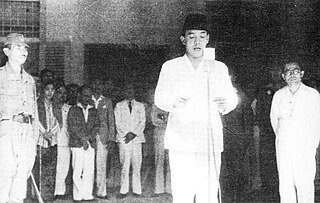
The Indonesian National Revolution, also known as the Indonesian War of Independence, was an armed conflict and diplomatic struggle between the Republic of Indonesia and the Dutch Empire and an internal social revolution during postwar and postcolonial Indonesia. It took place between Indonesia's declaration of independence in 1945 and the Netherlands' transfer of sovereignty over the Dutch East Indies to the Republic of the United States of Indonesia at the end of 1949.

The Royal Netherlands East Indies Army was the military force maintained by the Kingdom of the Netherlands in its colony of the Dutch East Indies, in areas that are now part of Indonesia. The KNIL's air arm was the Royal Netherlands East Indies Army Air Force. Elements of the Royal Netherlands Navy and Government Navy were also stationed in the Netherlands East Indies.
The Battle of Ambon occurred on Ambon Island in the Dutch East Indies, as part of the Japanese offensive on the Dutch colony during World War II. In the face of a combined defense by Dutch and Australian troops, Japanese forces conquered the island and its strategic airfield in several days. In the aftermath of the fighting, a major massacre of many Dutch and Australian prisoners of war by the Imperial Japanese Army (IJA) followed. Following the war, many of the IJA personnel were tried for war crimes.
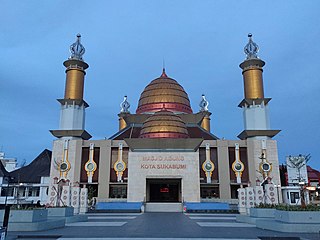
Sukabumi is a landlocked city surrounded by the regency of the same name in the southern foothills of Mount Gede, in West Java, Indonesia, about 100 km (62 mi) south of the national capital, Jakarta.

The Battle of Borneo was a successful campaign by Japanese Imperial forces for control of Borneo island and concentrated mainly on the subjugation of the Raj of Sarawak, Brunei, North Borneo, and the western part of Kalimantan that was part of the Dutch East Indies. The Japanese main unit for this mission was the 35th Infantry Brigade led by Major General Kiyotake Kawaguchi.
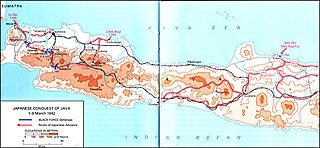
The Battle of Java was a battle of the Pacific theatre of World War II. It occurred on the island of Java from 28 February – 12 March 1942. It involved forces from the Empire of Japan, which invaded on 28 February 1942, and Allied personnel. Allied commanders signed a formal surrender at Japanese headquarters at Bandung on 12 March.
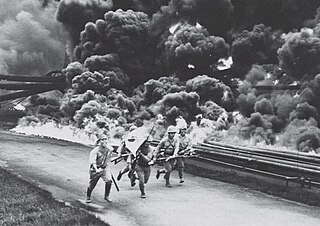
The First Battle of Balikpapan took place on 23–25 January 1942, off the major oil-producing town and port of Balikpapan, on Borneo, in the Netherlands East Indies. After capturing mostly-destroyed oilfields at Tarakan, Japanese forces send an ultimatum to the Dutch that they would be executed if they destroyed the oilfields there, to no avail.

General Simon Hendrik Spoor was the Chief of Staff of the Royal Netherlands East Indies Army and the Royal Dutch Army in the Dutch East Indies, from 1946 to 1949, during the Indonesian National Revolution.

Padalarang Station is a railway station complex in Padalarang, West Bandung Regency, West Java, Indonesia. The complex is planned to serve long-distance train services from Kereta Api Indonesia, commuter trains from KAI Commuter, and Jakarta-Bandung high-speed trains from Kereta Cepat Indonesia China (KCIC). The complex is in the form of two different station buildings, each operated by KAI and KCIC, and connected via a pedestrian bridge.

The Invasion of Sumatra was the assault by Imperial Japanese forces on the Dutch East Indies that took place from 14 February to 28 March 1942. The invasion was part of the Pacific War in South-East Asia during World War II and led to the capture of the island. The invasion of Sumatra was planned to occur prior to the invasion of Java to destroy the west flank of the allies and to give access to Java.

Suryadarma Air Force Base is one of the Indonesian Air Force bases on Java. Formerly known as Kalijati Airfield, it is located in the village of Kalijati, in the kabupaten of Subang in West Java.

In Dutch historiography, Bersiap refers to the violent and chaotic beginning of the Indonesian National Revolution following the end of World War II in Asia. In Indonesia, the term Berdaulat ("Sovereign") is also used for this transitional period. It began after Sukarno's proclamation of Indonesian Independence on 17 August 1945 and culminated during the power vacuum between the withdrawal of Japanese occupational forces and the gradual buildup of a British military presence, before the official handover to a Dutch military presence in March 1946.

Sultan Hamid II was the 7th Sultan of Pontianak and the only President of the State of West Kalimantan from 1946 to its disestablishment in 1950. He was the eldest son of Sultan Syarif Muhammad Alkadrie. He was of mixed Malay-Arab ancestry and was raised by two British nationals — Salome Catherine Fox and Edith Maud Curteis.

The APRA coup d'état or the January 23 coup d'etat was a coup d'état by Raymond Westerling's Legion of the Just Ruler (APRA) to capture Bandung and Jakarta, with the aim to overthrow Sukarno's unitary Republic of Indonesia. Westerling was a demobilised Dutch Captain of the KNIL, who sought to preserve the federal Republic of the United States of Indonesia, which retained the support of the Netherlands and various minority elements. Westerling's forces succeeded in capturing Bandung in the early hours of 23 January 1950.
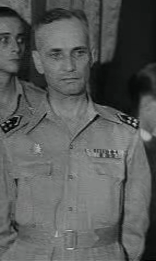
Major general Dirk Reinhard Adelbert van Langen was a member of the chief of staff of the Royal Netherlands East Indies Army (KNIL), the territorial commander of East Java, and commander of the T-Brigade of the Royal Netherlands Army from 1946 to 1949, during the Indonesian National Revolution.

The Battle of Tjiater Pass occurred between 5 and 7 March 1942 during the Dutch East Indies campaign between invading Japanese forces and the Dutch colonial forces, supported by warplanes from the Royal Air Force. It was fought over control of the Tjiater Pass, as part of an attempted defense of the city of Bandung.

The Battle of Leuwiliang was a battle during the Dutch East Indies campaign of the Pacific War that took place between 3 and 5 March 1942. Australian forces, supported by American artillery batteries and British tanks, launched a holding action starting at Leuwiliang, West Java, to cover the retreat of allied Dutch forces in the face of the Japanese invasion of Java.

The Battle of Kalijati occurred between 1 and 3 March 1942 during the Dutch East Indies campaign between invading Japanese forces and the Dutch colonial forces. It was fought over control of the Kalijati Airfield in Subang.

The Overvalwagen was an armored car or armored personnel carrier that saw service with the Royal Dutch East Indies Army and its auxiliary forces. It was used during the Second World War's Dutch East Indies Campaign.

The Battle of Bojong Kokosan was fought on 9-12 December 1945 in the Sukabumi Regency of West Java as a part of the Indonesian National Revolution, when a British army convoy carrying prisoners of war and internees to Bandung was ambushed by local Indonesian freedom fighters near Cicurug. The conflict is considered one of the first instances of de facto recognition of the Republic of Indonesia by the Western Allies, as the convoy's negotiator was able to successfully secure safe passage to Bandung on the 12th.
References
- 1 2 3 4 Immerzeel, Bert (22 October 2010). "Politieschool onder vuur". JavaPost.nl (in Dutch). Retrieved 27 August 2022.
- 1 2 Jong, Loe de (1984). The Kingdom of the Netherlands During World War II: Volume 11a, Part 2 (PDF) (in Dutch). Leiden: Sdu. ISBN 9789012048996.
- 1 2 Immerzeel, Bert (1 March 2011). "Lou de Jong en het bombardement op Soekaboemi". JavaPost.nl (in Dutch). Retrieved 27 August 2022.